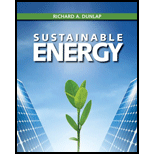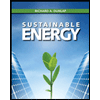
Sustainable Energy
1st Edition
ISBN: 9781133108689
Author: Richard A. Dunlap
Publisher: Cengage Learning
expand_more
expand_more
format_list_bulleted
Concept explainers
Question
Chapter 3, Problem 7P
To determine
Calculate the amount of coal each person process, on average, per day.
Expert Solution & Answer
Want to see the full answer?
Check out a sample textbook solution
Students have asked these similar questions
4-7 Nitrogen (molecular weight 28) expands reversibly in perfectly thermally insulated
cylinder from 3.5bar, 200°C to a volume of 0.09m. If the initial volume occupied was
0.03m³, calculate the work done during the expansion. Assume nitrogen to be perfect
gas and take Cv = 0.741kJ/kg.K
(9.31kJ)
4-8 1kg of air at 1.02bar, 20°C is compressed reversibly according to a law p.V¹³ = const.,
to a pressure of 5.5bar. Calculate the work done on the air and the heat flow to or from
the cylinder walls during the compression.
(133.5kJ/kg; -33.38kJ/kg)
able to help me with the question below with references (APA) for revision purpose
Structural InvestigationThe Building Maintenance and Strata Management Act 2004 interprets “Structural elements,for a building means an internal or external load-bearing component of the building or part ofthe building that is essential to the stability of the building but exclude any door or window.”Loading-bearing components such as wall, column or beam, etc, are subjected to externalforces.
(a) Interpret the diagnosis of a structural defect and discuss FOUR (4) external forces ona structure element that may cause structural cracks.(b) Discuss the effects of alkali-silica reaction on concrete structures and formulateFOUR (4) preventive measures.(c) Discuss the differences between chloride attack and sulphate attack on concretestructures(d) Formulate preventive measures to prevent or reduce chloride and sulphate attack onconcrete structures
Hard FinishesNatural timber flooring such as timber strips…
Determine the following "Side Shot" elevations given the following information:
Knowledge Booster
Learn more about
Need a deep-dive on the concept behind this application? Look no further. Learn more about this topic, civil-engineering and related others by exploring similar questions and additional content below.Similar questions
- Convert the Followingarrow_forwardSolve for the following right triangle for missing parts: - Angle A - Angle B - Side a - Areaarrow_forwardYOUR TOP STADIA CROSSHAIR IN YOUR LEVEL YEILDS A Roo READING of 7.32 FT. YOUR BOTTOM STADIA CROSSHAIR READS 6.23 FT. How FAR AWAY FROM YOUR INSTRUMENT (LEVEL) IS YOUR STATION WHERE YOUR PHilly Roo IS LOCATED:arrow_forward
- SITUATION. A uniform live load of 16 kN/m and a single concentrated live force of 34 kN are placed on the top beams. If the beams also support a uniform dead load of 3 kN/m, determinearrow_forwardComplete the profile leveling notes in Table 1. Show the arithmetic check and sample calculations of your work. Draw a neat sideview sketch showing the location of all stations and indicate on the sketch all of the numbers in your completed table.arrow_forward3. A level loop was run starting at BM 20 and going clockwise around the loop shown below in Figure 2. The given known elevation of BM 20 is 1418.013 ft. When closing the level loop, BM 20 was found to have an elevation of 1417.890 ft. (a) Adjust the elevation of each station to correct for error. Show sample calculations of your work. (b) What is the accuracy ratio of the survey? BM 20 Elev. 1418.013 2.3 mi BM 20A Observed Elev. 1234.567 2.7 mi 1.6 mil 0.9 mi BM 20B Observed Elev. 1357.913 BM 20C Observed Elev. 1396.963arrow_forward
- A W14 x 82 with 20 ft length column is part of a braced frame. The load and moments computed from service loads, and bending is about the x axis are (axial compressive dead load of 63 k; axial compressive live load of 76 k; upper dead moment of 32 ft-k; upper live moment of 56 ft-k; lower dead moment of 65 ft-k; lower live moment of 95 ft-k; the moments cause the member to bend in double curvature). Determine the lateral-torsional buckling modification factor C₁. ial live load ofarrow_forwardPROBLEM 1 Find the reaction at A and F. Compute for the force in members AB, BD, and DF. Use Method of Joints OR Method of Sections OR both. 3m B D C E 3m 100KN 3m 4marrow_forwardI need detailed help solving this exercise from homework of Engineering Mathematics II.I do not really understand how to do, please do it step by step, not that long but clear. Thank you!P.S.: Please do not use AI, thanks!arrow_forward
arrow_back_ios
SEE MORE QUESTIONS
arrow_forward_ios
Recommended textbooks for you

 Engineering Fundamentals: An Introduction to Engi...Civil EngineeringISBN:9781305084766Author:Saeed MoaveniPublisher:Cengage Learning
Engineering Fundamentals: An Introduction to Engi...Civil EngineeringISBN:9781305084766Author:Saeed MoaveniPublisher:Cengage Learning Solid Waste EngineeringCivil EngineeringISBN:9781305635203Author:Worrell, William A.Publisher:Cengage Learning,
Solid Waste EngineeringCivil EngineeringISBN:9781305635203Author:Worrell, William A.Publisher:Cengage Learning, Sustainable EnergyCivil EngineeringISBN:9781133108689Author:Richard A. DunlapPublisher:Cengage Learning
Sustainable EnergyCivil EngineeringISBN:9781133108689Author:Richard A. DunlapPublisher:Cengage Learning


Engineering Fundamentals: An Introduction to Engi...
Civil Engineering
ISBN:9781305084766
Author:Saeed Moaveni
Publisher:Cengage Learning

Solid Waste Engineering
Civil Engineering
ISBN:9781305635203
Author:Worrell, William A.
Publisher:Cengage Learning,

Sustainable Energy
Civil Engineering
ISBN:9781133108689
Author:Richard A. Dunlap
Publisher:Cengage Learning